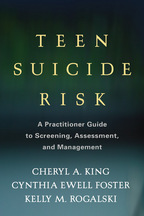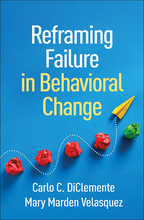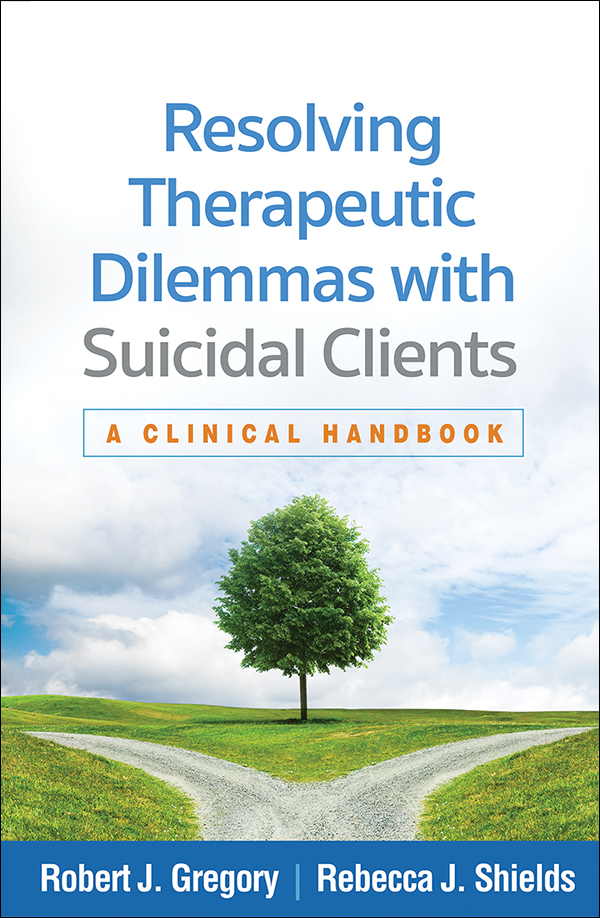Resolving Therapeutic Dilemmas with Suicidal Clients
A Clinical Handbook
Robert J. Gregory and Rebecca J. Shields
HardcoverPaperbacke-bookprint + e-book
Hardcover
pre-orderApril 24, 2026
ISBN 9781462562688
Price: $68.00 218 Pages
Size: 6" x 9"
Paperback
pre-orderApril 24, 2026
ISBN 9781462562671
Price: $45.00218 Pages
Size: 6" x 9"
“Organized around real-world therapeutic dilemmas, this book is a valuable reference and guide for clinicians and graduate students across disciplines who seek to deepen their understanding of client-centered, recovery-focused care for those navigating suicide risk. Readers will benefit from the actionable tools and compelling clinical vignettes, and from the emphasis on therapist self-awareness, alliance repair, and fostering authentic engagement—critical competencies for effective suicide treatment. Blending clinical wisdom with empirical rigor, this book will inspire and facilitate discussions around complex and nuanced decision making, risk assessment, alliance management, and client ownership of recovery.”

—Jennifer J. Muehlenkamp, PhD, Department of Psychology, University of Wisconsin–Eau Claire
“This 'must-read' book addresses the practical problems, countertransferences, and pressures that busy clinicians struggle with when working with suicidal patients. It provides solutions and—perhaps more important—hope and optimism. The book is organized around 18 scenarios that are familiar to all experienced clinicians, and suggests pragmatic techniques for helping patients move from simply managing their painful symptoms to recovery.”

—Richard F. Summers, MD, Department of Psychiatry, Perelman School of Medicine of the University of Pennsylvania
“This unique book succeeds in offering an accessible, evidence-based framework for understanding and intervening with clients with suicidal ideation. Regardless of one's theoretical orientation, the tools and principles provided in this book are practical, adaptable, and deeply human. Clinicians are equipped with clear strategies to engage suicidal clients meaningfully and effectively. This book is essential reading for all professionals—from trainees to seasoned clinicians—seeking to expand their therapeutic toolkits and offer hope to clients in their darkest moments.”

—Patrick Luyten, PhD, Faculty of Psychology and Educational Sciences, University of Leuven, Belgium; Research Department of Clinical, Educational and Health Psychology, University College London, United Kingdom
“This book is a unique, important, and remarkably impactful contribution to the area of clinical practice that is arguably the most anxiety provoking for providers. Clinicians are often at a loss for how best to respond when a client experiencing a suicidal crisis voices unshakable hopelessness, despair, or rage. Gregory and Shields offer specific, expert guidance founded in an empirically informed model, vast experience, and clinical wisdom. The book helps clinicians develop and refine critical skills for facing the most challenging clinical scenarios. Not only will this book calm clinicians' anxiety, it also will improve the quality of care and help save lives.”

—M. David Rudd, PhD, ABPP, Distinguished University Professor of Psychology and President Emeritus, The University of Memphis
—Jennifer J. Muehlenkamp, PhD, Department of Psychology, University of Wisconsin–Eau Claire
“This 'must-read' book addresses the practical problems, countertransferences, and pressures that busy clinicians struggle with when working with suicidal patients. It provides solutions and—perhaps more important—hope and optimism. The book is organized around 18 scenarios that are familiar to all experienced clinicians, and suggests pragmatic techniques for helping patients move from simply managing their painful symptoms to recovery.”
—Richard F. Summers, MD, Department of Psychiatry, Perelman School of Medicine of the University of Pennsylvania
“This unique book succeeds in offering an accessible, evidence-based framework for understanding and intervening with clients with suicidal ideation. Regardless of one's theoretical orientation, the tools and principles provided in this book are practical, adaptable, and deeply human. Clinicians are equipped with clear strategies to engage suicidal clients meaningfully and effectively. This book is essential reading for all professionals—from trainees to seasoned clinicians—seeking to expand their therapeutic toolkits and offer hope to clients in their darkest moments.”
—Patrick Luyten, PhD, Faculty of Psychology and Educational Sciences, University of Leuven, Belgium; Research Department of Clinical, Educational and Health Psychology, University College London, United Kingdom
“This book is a unique, important, and remarkably impactful contribution to the area of clinical practice that is arguably the most anxiety provoking for providers. Clinicians are often at a loss for how best to respond when a client experiencing a suicidal crisis voices unshakable hopelessness, despair, or rage. Gregory and Shields offer specific, expert guidance founded in an empirically informed model, vast experience, and clinical wisdom. The book helps clinicians develop and refine critical skills for facing the most challenging clinical scenarios. Not only will this book calm clinicians' anxiety, it also will improve the quality of care and help save lives.”
—M. David Rudd, PhD, ABPP, Distinguished University Professor of Psychology and President Emeritus, The University of Memphis










